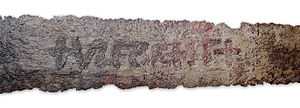Ulfberht
| Ulfberht | |
|---|---|
|
+ULFBEHT+ variant inlay in a sword from the early 9th century | |
| Type | Sword |
| Service history | |
| In service | Approximately 800–1000 AD |
| Used by |
Finns Danes Norwegians Swedes Varangians |
| Wars | Viking expansion |
| Production history | |
| Designer | Possibly "Ulfberht" |
| Designed | Early 800s AD |
| Produced | 800–1000 AD |
| Number built | 171 found |
| Specifications | |
| Weight | avg. 1.2 kg (2.7 lb) |
| Length | avg. 91 cm (36 in) |
| Width | 5 cm (2 in) |
|
| |
| Blade type | Double-edged, straight bladed, slight taper |
| Hilt type | One-handed with pommel, variable guard |
| Head type | acute distal taper, and point |
Ulfberht is a modern transcription of the inscription +VLFBERH+T, found on some Early Middle Ages Germanic swords of the 8th to 11th century. Swords so inscribed have been found in many parts of Europe, most numerously in Scandinavia. They are believed to originate from the Taunus region of Germany in what was the Frankish realm.[1]
There are many variations of the inscription, including +VLFBERHT+ or VLFBERH+T.[2] The inscription is a Frankish personal name and became the basis of a trademark of sorts, used by multiple bladesmiths for several centuries. Stalsberg argues that a smith is unlikely to have been literate, and that the presence of crosses in the signature suggest an ecclesiastical or monastic origin. She discusses how the swords may have reached Scandinavia, suggesting smuggling, looting by vikings, or as ransom for dignitaries captured by vikings.[2]
Most "Ulfberht" swords are of Oakeshott Type X form. They are forged from excellent steel with a very low content of sulfur and phosphorus and up to 1.1% carbon. This steel was most likely acquired through trade through the Volga trade route, where ingots of the steel were obtained from central Asian countries: who were producing crucible steel to emulate the famous wootz steel of India.[3][4]
See also
- Ingelrii, a similar inscription
References
- ↑ Wunderwaffen aus dem Kloster; Süddeutsche; 30 July 2014 (German)
- ↑ 2.0 2.1 Anne Stalsberg: The Vlfberht sword blades reevaluated
- ↑ Alfred Pothmann (ed.): Das Zeremonialschwert der Essener Domschatzkammer. Aschendorff, Münster 1995, ISBN 3-402-06243-7
- ↑ David Edge, Alan Williams: Some early medieval swords in the Wallace Collection and elsewhere, Gladius XXIII, 2003, pp. 191-210
Further reading
- Alfred Geibig: Beiträge zur morphologischen Entwicklung des Schwertes im Mittelalter. Eine Analyse des Fundmaterials vom ausgehenden 8. bis zum 12. Jahrhundert aus Sammlungen der Bundesrepublik Deutschland, Dissertation, Neumünster, 1991
- Friedrich E. Grünzweig: Das Schwert bei den Germanen. Kulturgeschichtliche Studien zu seinem Wesen vom Altertum bis ins Hochmittelalter. (= Philologica Germanica, 30) Fassbaender, Vienna 2009, ISBN 978-3-902575-18-0
- Ewart Oakeshott: The Sword in the Age of Chivalry, 1994, ISBN 978-0851153629
- Alan R. Williams, Methods of Manufacture of Swords in Medieval Europe: Illustrated by the Metallography of Some Examples, Gladius 13 (1977), S. 75 - 101
- Alan Williams, A Metallugical Study of Some Viking Swords PDF, Gladius 29 (2009), 121-184
- M. Müller-Wille: Ein neues ULFBERHT-Schwert aus Hamburg. Verbreitung, Formenkunde und Herkunft, Offa 27, 1970, 65-91
- Ian Peirce, Ewart Oakeshott: Swords of the Viking Age. The Boydell Press, 2002, ISBN 978-0851159140
External links
 Media related to Ulfberht swords at Wikimedia Commons
Media related to Ulfberht swords at Wikimedia Commons
